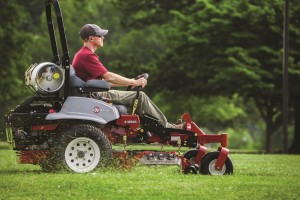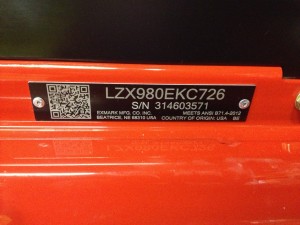Everyone loves a well-striped lawn. Whether at a Major League ballpark, or your own back yard, something about lawn striping exemplifies quality like a pinstriped business suit. In many cases, the best lawn stripes come from a combination of cutting experience, trial and error, and good artistic sense. At the same time, certain basic striping techniques and an understanding of what causes a good pattern can help you maximize your own craftsmanship and your lawn’s beauty.
Keep your lawn healthy
It all starts with a healthy lawn and good cut quality. That said, striping does help unhealthy turf look a little better. The best, most clearly defined stripes get noticed, and clear definition starts with a professional grade cutting deck. If your lawn looks good without any striping, if you can easily achieve a “pool table” look after a fresh cut with your current mower, then you can realistically expect a quality pattern.
Make sure your equipment is properly tuned
Whether you intend to stripe or not, proper deck tuning simply means that you’re maximizing the quality your deck can provide. It should have a slightly positive rake (meaning the rear of the deck is just a little bit higher than the front), your blades should be sharp and well aligned (which can be undone after impact with any solid objects).
With a properly tuned cutting deck, grass will stand up straight under the vacuum forces created by your deck blades in operation. Some blades and decks have more vacuum efficiency than others, but any striping that can occur has to happen after the deck has passed. In its essence, striping is nothing more than bending the blades of grass in one direction, uniformly across the entire width of cut, in a contrasting pattern.
Does your deck really need a striper?
Before investing money in a professional-grade striping mechanism, you need to check a few things. First, consider your mower. You may already be getting a good quality of stripe from the basic design of your mower’s cutting deck. Some decks even have a drag shield installed to protect the operator from any thrown object hazards. While the drag shield itself has not been designed as a striper, it may do so anyway simply because it will lean grass in the direction of travel.
What type of striper works best?
Striper designs run the gamut from heavy-duty steel rollers, to flexible skirts, to brushes and chains. Most all designs fit up to the back edge of the cutting deck, but in some cases may trail behind the mower itself. The best choice for you may come down to personal preference based on cost, ease of installation, removal, or adjustability.
That said, roller stripers have the lowest tendency to push, or “bull doze” material in front of the striper. When this happens (and is most commonly seen with drag stripers), grass clippings pile up until they become heavy enough to roll under the skirt in clumps. You may get a decent stripe, but the clumping could ruin the quality of cut. All things considered, your dealer most often is the best source of information when it comes to matching the right striper design to your particular mower.
Can your grass hold a stripe?
Before getting started, consider the type of grass you typically mow, and the seasonal weather conditions. Cool season grasses found in northern U.S. climates tend to stripe more effectively than in southern climates due in large part to their differences in flexibility. The same machine and striper can, for example, achieve a crisper pattern in Wisconsin fescue than perhaps it can in Kentucky. An example at one end of the scale can be found in Florida. The St. Augustine grass there is so robust and rigid that it simply does not want to lean over in the direction of travel.
How does the sun affect your stripe quality?
Regardless of how you bend a blade of grass, stripes are perceived by the light reflected from each blade of grass in contrast to the next. The contrasting effect will vary in different ambient light conditions.
In other words, the striping appearance will change throughout the day as the angle of the sun’s rays to the grass changes. The most contrast is created if the directions of travel is in the same direction as the sun’s rays. The more you lean the grass over, the more contrast you will see.
In fact, grass blades themselves tend to reflect light better on one side of the blade than the other, so this can enhance the stripe pattern in just the right lighting.
With this in mind, you may want to experiment with the stripe direction that looks best on your lawn. A north-south direction may reflect its pattern more consistently than an east-west direction due to the position of your lawn, and its hills and trees, in relation to the sun’s movement during the day.
Keep your lines straight
Once you have decided on the best pattern and begun to mow, keep your lines straight by maintaining your focus far ahead. Quite often, the closer your sight line is to your mowing deck, the more your mowing tends to wander. This remains true whether you are striping or not. Also, balance your speed and make sure you overlap the stripes to avoid unsightly gaps. Going full speed may result in a lighter stripe and uneven cut, while going too slow may challenge your ability to keep a straight line.
Practice makes permanent
Remember, the best lawn stripes may come from gaining experience at what works best for your conditions. It also comes from learning the basics. Practicing good habits makes those habits more permanent. If you don’t like your results, don’t lose heart. Keep the grass healthy, review basic striping techniques, and try it again. With each pass, you will gain experience and soon be able to transform any nice lawn into a real head-turner.










